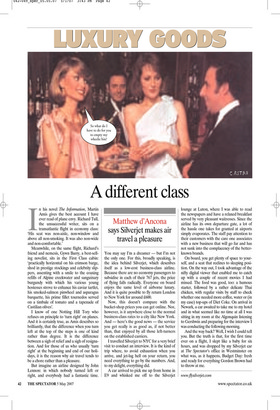A different class
Matthew d’Ancona says Silverjet makes air travel a pleasure
In his novel The Information, Martin Amis gives the best account I have ever read of plane envy. Richard Tull, the unsuccessful writer, sits on a transatlantic flight in economy class: ‘His seat was non-aisle, non-window and above all non-smoking. It was also non-wide and non-comfortable.’ Meanwhile, on the same flight, Richard’s friend and nemesis, Gywn Barry, a best-selling novelist, sits in the First Class cabin: ‘practically horizontal on his crimson barge, shod in prestige stockings and celebrity slippers, assenting with a smile to the coaxing refills of Alpine creekwater and sanguinary burgundy with which his various young hostesses strove to enhance his caviar tartlet, his smoked-salmon pinwheel and asparagus barquette, his prime fillet tournedos served on a timbale of tomato and a tapenade of Castilian olives’.
I know of one Notting Hill Tory who refuses on principle to ‘turn right’ on planes. And it is certainly true, as Amis describes so brilliantly, that the difference when you turn left at the top of the steps is one of kind rather than degree. It is the difference between a sigh of relief and a sigh of resignation. And for those of us who usually ‘turn right’ at the beginning and end of our holidays, it is the reason why air travel tends to be a chore rather than a pleasure.
But imagine an airline designed by John Lennon: in which nobody turned left or right, and everybody had a fantastic time. You may say I’m a dreamer — but I’m not the only one. For this, broadly speaking, is the idea behind Silverjet, which describes itself as a low-cost business-class airline. Because there are no economy passengers to subsidise in each of their 767 jets, the price of flying falls radically. Everyone on board enjoys the same level of airborne luxury. And it is quite possible to fly return London to New York for around £600.
Now, this doesn’t compare with the bucket-shop prices you can get online. Nor, however, is it anywhere close to the normal business-class rates to a city like New York. And — here’s the good news — the service you get really is as good as, if not better than, that enjoyed by all those left-turners on the established carriers.
I travelled Silverjet to NYC for a very brief visit to conduct an interview. It is the kind of trip where, to avoid exhaustion when you arrive, and jet-lag hell on your return, you need everything to go by the numbers. And, to my delight, everything did.
A car arrived to pick me up from home in E9 and whisked me off to the Silverjet lounge at Luton, where I was able to read the newspapers and have a relaxed breakfast served by very pleasant waitresses. Since the airline has its own departure gate, a lot of the hassle one takes for granted at airports simply evaporates. The staff pay attention to their customers with the care one associates with a new business that will go far and has not sunk into the complacency of the betterknown brands.
On board, you get plenty of space to yourself, and a seat that reclines to sleeping position. On the way out, I took advantage of the nifty digital viewer that enabled me to catch up with a couple of recent movies I had missed. The food was good, too: a humous starter, followed by a rather delicate Thai chicken, with regular visits by staff to check whether one needed more coffee, water or (in my case) top-ups of Diet Coke. On arrival in Newark, a car awaited to take me to my hotel and in what seemed like no time at all I was sitting in my room at the Algonquin listening to Gershwin and preparing for the interview I was conducting the following morning.
And the way back? Well, I wish I could tell you. But the truth is that, for the first time ever on a flight, I slept like a baby for six hours, and was dropped by my Silverjet car at The Spectator’s office in Westminster on what was, as it happens, Budget Day: fresh and ready for everything Gordon Brown had to throw at me.
www.flysilverjet.com


































































































 Previous page
Previous page